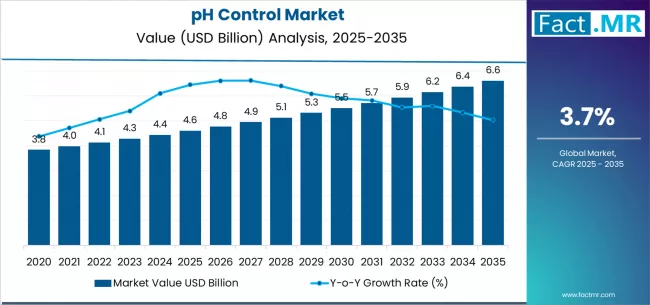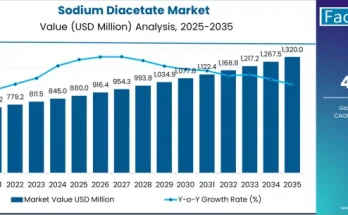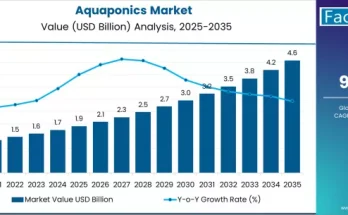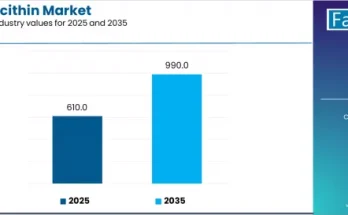The global pH control market stands at the threshold of a decade-long expansion that promises to reshape food processing technologies and beverage formulation solutions. According to a new report by Fact.MR, the market is forecast to grow from USD 4.6 billion in 2025 to USD 6.6 billion by 2035, registering a CAGR of 3.7% during the forecast period.
As industries prioritize safety, taste stability, and sustainability, pH control agents have become indispensable ingredients in processed food, beverage, and fermentation applications. Their ability to regulate acidity, enhance preservation, and optimize product consistency continues to drive widespread adoption across manufacturing sectors.
Strategic Market Drivers
- Food and Beverage Innovation Accelerating Demand
The food and beverage industry remains the largest consumer of pH control agents. Rising demand for clean-label products, natural acidulants, and formulation stability is propelling the use of citric acid, phosphoric acid, and lactic acid salts. These agents play a vital role in flavor enhancement, microbial control, and shelf-life extension across bakery, dairy, meat, and beverage segments.
Manufacturers are also shifting toward organic and fermentation-derived acids in response to consumer demand for additive transparency and sustainability-certified ingredients.
- Expanding Role in Pharmaceuticals and Nutraceuticals
In the pharmaceutical and nutraceutical sectors, pH control agents are used to ensure bioavailability, formulation stability, and controlled release in drug and supplement production. The sector’s growing emphasis on precision formulations is creating new opportunities for premium acidulant and buffer manufacturers.
- Growing Emphasis on Sustainable and Eco-friendly Production
Sustainability is reshaping sourcing and manufacturing practices. Leading producers are investing in biobased acids and low-carbon production technologies, minimizing waste and energy consumption. This shift aligns with global sustainability mandates and supports long-term market resilience.
- Beverage Reformulation and Fermentation Growth
Rising demand for functional and fermented beverages—including kombucha, flavored waters, and dairy alternatives—is fueling pH control agent usage. Acids and salts play a critical role in maintaining flavor balance, microbial safety, and foam stability, ensuring consistent quality across innovative beverage formats.
Browse Full Report: https://www.factmr.com/report/467/ph-control-salt-market
Regional Growth Highlights
North America: Center of Formulation Innovation
The U.S. and Canada lead in food technology innovation, particularly in functional and plant-based foods. Regulatory emphasis on label transparency and clean ingredient sourcing continues to influence pH control formulations in processed foods and ready-to-drink beverages.
Europe: Sustainability and Clean Label Lead the Way
Europe remains a hub for sustainable ingredient production, with strong adoption of natural and organic acidulants. Stringent EU regulations on food additives and consumer-driven demand for environmentally conscious manufacturing are pushing producers toward greener pH control systems.
East Asia: High-Volume Manufacturing and Consumption
East Asia—especially China and Japan—represents one of the fastest-growing regional markets, driven by a robust food processing industry, rapid urbanization, and increasing investment in biotechnology and fermentation-based ingredient manufacturing.
Emerging Economies: Rapid Industrialization and Urban Food Demand
Regions such as South Asia, Latin America, and the Middle East are witnessing surging demand for processed foods and beverages. Government-led investments in food safety, packaging, and manufacturing infrastructure are expected to amplify pH control market penetration over the next decade.
Market Segmentation Insights
By Product Type
- Acidulants (Citric Acid, Phosphoric Acid, Acetic Acid, Lactic Acid)
- pH Adjusters (Sodium Citrate, Potassium Carbonate, Calcium Hydroxide)
- Buffering Agents (Phosphates, Citrates, Carbonates)
By End Use
- Food & Beverages – Dominant application across processed foods, bakery, confectionery, and drinks
- Pharmaceuticals & Nutraceuticals – Increasing demand for pH stabilization in formulations
- Personal Care & Cosmetics – Expanding use in skincare and haircare for pH balance
- Industrial Applications – Growing use in fermentation, water treatment, and chemical processing
Challenges and Market Considerations
- Raw Material Price Fluctuations: Variability in sugar and fermentation feedstock costs affects production economics.
- Regulatory Scrutiny: Stringent additive labeling and food safety regulations necessitate ongoing R&D in formulation transparency.
- Competition from Natural Alternatives: Manufacturers face pressure to replace synthetic acidulants with naturally sourced compounds.
- Supply Chain Constraints: Transportation and raw material disruptions continue to challenge ingredient availability and pricing stability.
Competitive Landscape
The global pH control market features a mix of multinational ingredient suppliers and specialty acid producers, focusing on sustainable chemistry, innovation, and localized production networks.
Key companies are leveraging biotechnology advancements, renewable raw materials, and formulation expertise to maintain competitiveness and meet evolving consumer preferences.
Key Players in the pH Control Market:
- Tate & Lyle
- ADM (Archer Daniels Midland)
- Cargill
- Corbion
- Jungbunzlauer
- Kerry Group
- DSM-Firmenich
- Novozymes
- FBC Industries
- Archer Chemicals
Recent Developments
- May 2024 – Cargill expanded its biobased acidulant production facility in the U.S. to support demand for sustainable beverage formulations.
- January 2024 – Corbion introduced a new line of non-GMO lactic acid derivatives for natural food preservation and pH control.
- October 2023 – Jungbunzlauer launched an advanced buffering system for dairy alternatives, improving texture and taste consistency in plant-based products.
Future Outlook: Precision pH Management for a Sustainable Food Future
The next decade will redefine the pH control landscape, blending biotechnology, circular chemistry, and digital formulation tools to create smarter, cleaner ingredient systems.
As global food and beverage producers pursue sustainability, functionality, and flavor innovation, pH control agents will continue to serve as a cornerstone of safe, high-quality, and future-ready formulations.
Manufacturers that invest in green chemistry and region-specific ingredient innovation will lead the market toward a more resilient and sustainable future.



